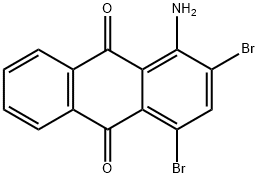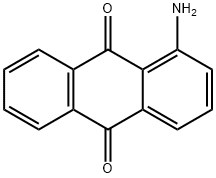BD0354753
1-Amino-2,4-dibromoanthraquinone , 98% , 81-49-2
CAS NO.:81-49-2
Empirical Formula: C14H7Br2NO2
Molecular Weight: 381.02
MDL number: MFCD00019155
EINECS: 201-354-0
| Pack Size | Price | Stock | Quantity |
| 5g | RMB64.00 | In Stock |
|
| 25g | RMB230.40 | In Stock |
|
| 100g | RMB864.00 | In Stock |
|
| others | Enquire |
Update time: 2022-07-08
PRODUCT Properties
| Melting point: | 226°C |
| Boiling point: | 550.4±50.0 °C(Predicted) |
| Density | 1.8218 (rough estimate) |
| refractive index | 1.6220 (estimate) |
| storage temp. | Amber Vial, -20°C Freezer, Under inert atmosphere |
| solubility | Chloroform (Slightly), Ethyl Acetate (Slightly) |
| form | Solid |
| pka | -3.09±0.20(Predicted) |
| color | Dark Red |
| Water Solubility | <0.1 g/100 mL at 23 ºC |
| Stability: | Stable. |
| CAS DataBase Reference | 81-49-2(CAS DataBase Reference) |
| IARC | 2B (Vol. 101) 2013 |
| NIST Chemistry Reference | 1-Amino-2, 4-dibromoanthraquinone(81-49-2) |
| EPA Substance Registry System | 1-Amino-2,4-dibromoanthraquinone (81-49-2) |
Description and Uses
ADBAQ and other aminoanthraquinones are key intermediates in the production of almost all anthraquinone dyes (HSDB 2009). Anthraquinones, including ADBAQ, are widely used as starting material for the manufacture of vat dyes, which are a class of water-insoluble dyes that can easily be reduced to a water-soluble and usually colorless form. In this form, they are readily impregnated into fibers and textiles. Oxidation then produces an insoluble colored form that is remarkably fast to washing, light, and chemicals. Vat dyes typically are used with cotton, wool, and cellulose acetate (NTP 1996).
Safety
| Symbol(GHS) |  GHS08 |
| Signal word | Warning |
| Hazard statements | H351 |
| Precautionary statements | P201-P202-P280-P308+P313-P405-P501a |
| Risk Statements | 36/37/38 |
| Safety Statements | 26-36/37/39 |
| TSCA | Yes |
| Hazardous Substances Data | 81-49-2(Hazardous Substances Data) |



